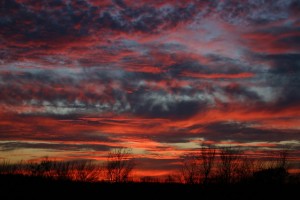Some time back, we had a customer make an inquiry to the effects of very low humidity coupled with extreme variances in temperature. I told Charles I would look into the thing, and possibly come up with a few conclusions about the topic. It turns out the effects of humidity and temperature variation on organic building supplies is a little more complicated than I’d initially thought, especially considering the wide variances among different wood species.
Kansans and Muscovites can look forward to this in about six months.
Further complicating a relatively simple inquiry is the fact that climactic variations throughout North America are extremely large. Virtually every condition in which man resides can be found somewhere in the United States. A blanket explanation or a simple chart is therefore impractical when considering the specific climactic occurrences one could encounter throughout the country.
The best thing a homeowner, contractor, or design specialist can do to ensure the maximum utility of their wood decking and siding products is to properly acclimate the wood to its new environment. I’ve written a little about this before. It is occasionally difficult for the contractor to exercise patience at this point of the process, as most of our orders are of a very time-sensitive nature. Skipping this important step in the process will only degrade the quality of the finish installation.
The science behind the nature of wood acclimation over time still fascinates me, however. It is impossible to predict exactly how any particular species will perform on site without first knowing the moisture content of the species at the point of installation, the length of time the acclimation process occurs on site, and the relative humidity and temperature variations of the installation climate. I’ll begin with some fundamental knowledge here, which is required for any further scientific explanation of this common and accepted variation in organic building supplies.
Simply put, relative humidity takes into account the pressure, temperature, and amount of water vapor present in the air to determine a uniform, temperature-neutral measure of the current air makeup. Relative humidity provides a little better measure of what’s actually going on as it relates to current weather conditions. I don’t know how much stock to put into the explanation found here, as I am not a scientist. I’m pretty sure that atoms bounce around at different rates depending on how warm they are. I leave further explanation of the phenomenon to the experts.
What’s important to the contractor and end-user is the net effect on the finished product. Checking is pretty common in dense timbers such as Ipe, where moisture within the timbers attempts to equalize with the moisture norms of its new environment over time. I don’t have a whole lot to say about other climates around North America. My experience in one of the most extreme climates in the world tells me that if it’s good enough for Kansas City, it’s probably going to be good enough for your location as well, so long as a few precautions are taken to value the overall appearance of the installation.
After doing some very basic research with the almanac, about the only other place on earth I can find with such a similarly severe continental steppe climate is that of Moscow. So, I’ll make the broad brushstroke here that woods such as Ipe, Cumaru, and Massaranduba would very likely take the pounding just about anywhere. No other places where people substantially congregate on earth experience the oppressive humidity, extreme hot and cold, and subsequent dryness associated with harsh winter with the steppe climate seen in Kansas City and Moscow. Five or six days a year, however, it is quite nice here. Probably most urban Russians could make a similar claim. Today is not one of those days. It is very likely to reach 105 degrees Fahrenheit here today with something meteorologists call a heat index in the neighborhood of 120 degrees. That means it’s pretty damned humid. So, if I’m still alive tomorrow, I’ll follow up on section II of this series. We’ll explore in greater detail just what to do about phenomenon such as today.
